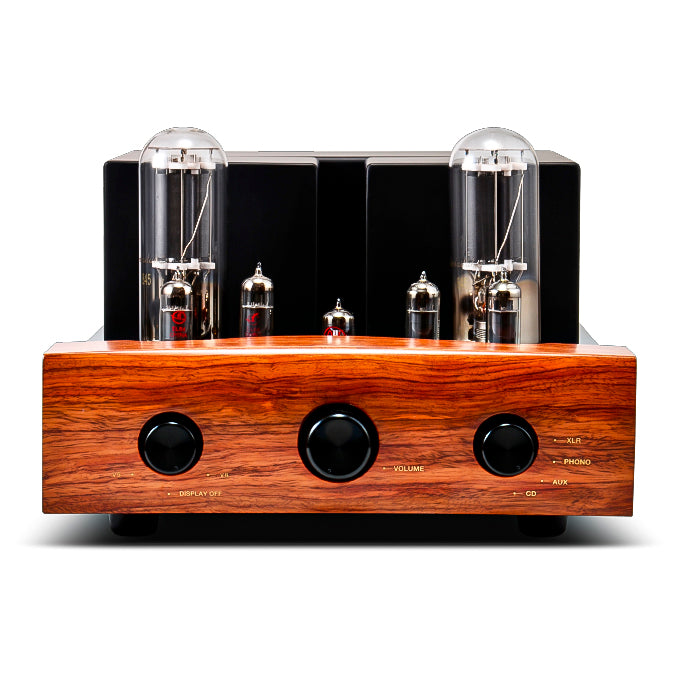I think that some people are working on vacuum tube amplifiers as a hobby of music appreciation and a choice to enjoy higher quality music from now on. What is a vacuum tube actually? I think there are doubts and anxieties about what to do with after-sales maintenance. This time I wrote about after-maintenance of such vacuum tubes.
Product page of vacuum tube amplifier is here
https://www.exclusive-audio.jp/shop/products/list.php?category_id=32
The product page of the photo amplifier is here
https://www.exclusive-audio.jp/shop/products/detail.php?product_id=628
Vacuum tubes are components like light bulbs that control voice signals and currents that have been used for decades before transistors and semiconductors were invented. In addition, vacuum tubes with the same standards and compatibility are manufactured from various manufacturers around the world, and can be replaced with vacuum tubes of different manufacturers than vacuum tubes that came with amplifiers. Materials, manufacturing processes and environments used in vacuum tubes of the same standard? Depending on the manufacturer, the sound is characteristic. Therefore, the fun of pursuing your favorite sound by replacing it with other manufacturers is also a big attraction of vacuum tube amplifier.
As for the replacement, it is easy to replace the plastic tube which has the role to arrange the disturbed voice signal in the vacuum tube and deliver it to the power amplifier. However, the output tube that amplifies and increases the audio signal sent from the pre-pipe requires bias adjustment to match the amount of current to the vacuum tube used. Thankfully, many amplifiers now have self-bias adjustments, eliminating the need for troublesome bias adjustments, and it is possible to easily replace vacuum tubes that are isomorphic and compatible.
Even if the vacuum tube is not replaced, so that the light bulb is consumable, if the vacuum tube is also used for a long time, the function will decline and replacement is necessary.
So, when is the lifetime of the vacuum tube, the time and timing of replacement?
One of the timings is when the vacuum tube breaks for some reason. It is easy to understand because the amplifier does not operate properly and the sound does not emit sound because air enters the glass tube which is in a vacuum state like the white hot bulb. It's more an accident than a lifetime.
And the other is life. In general, the vacuum tube has a considerable longevity and is said to be around 5,000 hours of use. As long as this, there is almost no rule such as exchange time. In fact, many of the vacuum tubes on the market and those of manufacturers that are said to be products are unused stock and used items that were manufactured decades ago. There are also masterpieces that sound good even after several decades depending on the usage method when used in audio equipment. Nevertheless, deterioration is progressing gradually, so I think that it is often used without realizing that performance has already fallen due to longevity.
Unlike broken patterns, which are easy to understand, where no sound comes out at all, the symptoms of lifetime are listened to, and the noise is riding on the sound... Is it straining a little sound? It is very ambiguous. If it seems to be different from the sound in memory, please doubt the deterioration and aging of the vacuum tube. It is a good addition, but it is hard to understand that it is affected by ear habits and system changes. Some amplifiers have a meter that can check the vacuum tube status at any time.
The product page of the photo amplifier is here.
https://www.exclusive-audio.jp/shop/products/detail.php?product_id=196
In general, it is a change in the mirror part at the top of the vacuum tube as a symptom of the lifetime and deterioration that can see the vacuum tube itself by the eye. This is a material that adsorbs impurities to prevent the deterioration of vacuum intensity inside the vacuum tube called getter, and is applied to part of the back side of the glass tube. Due to age and continuous use, the shining part of this silver color is peeled off, the color becomes thinner, and the inside of the vacuum tube can be blacked out. If you can see these conditions visually, you can determine the lifetime of the vacuum tube. So, let's check the decrease of the getter regularly as a guide of life.
The product page of the photo amplifier is here.
https://www.exclusive-audio.jp/shop/products/detail.php?product_id=511
However, there is no need to pay attention to the nervousness of the lifetime, and as mentioned above, while enjoying the difference of sound quality by replacing with the vacuum tube of the compatible model, sometimes wiping from the glass tube, using water-free ethanol on the part of the pin at the time of replacement, dirty and so on Simple maintenance is enough
If you put it flat, you can enjoy the vacuum tube amplifier with the ease of thinking that the light bulb you are using is bad recently, it has become dark, or crackling, such symptoms appear, and you have to replace, so I want you to try it without hesitation.





























